A variety of people have worked in the ToBo lab since its founding in 2003.
Anne Lee
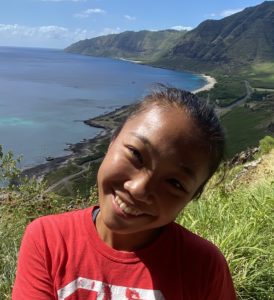 Master’s
Master’s
Hey there! Before graduate student life, I worked as a lab technician in the ToBo Lab. Most of the projects I worked on consisted of examining phylogenetics of different kinds of fish species such as Neoniphon aurolineatus, Myripristis chryseres, and Chaetodon tinkeri. I also started conducting research on the mesophotic refugia hypothesis to see if coral reef fish exhibit structure with depth.
As a grad student, my current research focuses on resolving the population genetic structure of the submesophotic snappers, Etelis coruscans and Etelis carbunculus. Instead of using microsatellites loci, I will be using single nucleotide polymorphisms (SNPs). SNPs have been shown to be more reliable and powerful than traditional techniques such as microsatellite loci for detecting population structure. Because these submesophotic Etetis snappers make up an important component of local fisheries in Hawaii and across the Indo-Pacific, it is important to understand genetic connectivity and population structure to make proper management implementations.
‘Ale‘alani Dudoit
 PhD
PhD
Limu-make-o-Hana , (deadly seaweed of Hana) is a toxic organism that is endemic to Hawaiʻi. Legend states that Hawaiian warriors applied this organism to their spears in battle and one touch would “bring sure death” to their enemies. Researchers later described this legendary limu as a new species of cnidarian zoanthid (colonial anemone), Palythoa toxica. This led to the discovery of palytoxin (PTX), which was described as one of the deadlest marine toxins ever discovered. Zoanthids of the genus Palythoa are distributed worldwide, and are found in shallow tropical and subtropical waters. Despite their ubiquity, particularly on Pacific coral reefs, there are only four species of Palythoa known from the Hawaiian Islands, P. psammophilia, P. vestitus, P. tuberculosa, and the rare P. toxica. I am interested in the distribution and origin of this toxin among zoanthid colonies throughout the Hawaiian Islands.
In addition to my research with zoanthids, I am also interested in the phylogeography of the coral banded shrimp, Stenopus hispidus. Being a popular marine ornamental shrimp and widely distributed from the Indo-Pacific to the western Atlantic Ocean; I am interested in how barriers and/or geological changes affect the gene flow of this species.
‘Ale‘alani’s dissertation was titled “Oh, The Places You’ll Go: Phylogeography and population genetic connectivity insights in widely distributed marine taxa”.
Mariana Rocha de Souza
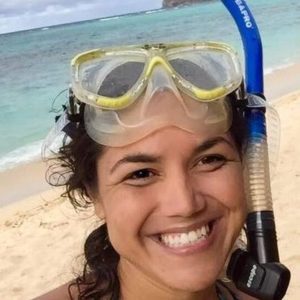 PhD
PhD
I am broadly interested in a wide range of topics dealing with the ecology and evolution of marine organisms. My previous research, during the master and undergraduate studies, has been primarily focused in the taxonomy and systematics of Scyphozoa.
Mariana’s dissertation was titled “Role of coral symbiont in coral resilience under future ocean conditions“
Sean Canfield

PhD
I study the biogeography of horn sharks (genus Heterodontus), examining their evolution over deep time-scales and looking at contemporary population genetic structure using next-generation sequencing technologies. Other than being completely adorable, these sharks are interesting because they don’t appear to travel very far at all, particularly through the open ocean. That raises all kinds of interesting questions about their evolution (the order Heterodontiformes is about 200 million years old!) and about how their populations are structured (how did they make it to islands, like Santa Catalina Island in California, Guadalupe Island in Mexico, and the Galapagos Islands, and how often do they make that trip?). Answering these questions can tell us a lot about how to develop and implement good conservation strategies for what I call the “lazy” sharks!
Sean’s dissertation was titled “Population genetics of the California Horn Shark (Heterodontus francisci)“.
 Postdoctoral Fellow
Postdoctoral Fellow
I did a joint honors degree in Marine Biology and Zoology at Bangor University, Wales and my Phd in Marine Biology at Victoria University of Wellington, New Zealand. Essentially I’m a generalist researcher who loves to work on almost any marine organism (and sometimes even birds). Mostly I’m driven by ecological questions and the need to preserve coral reefs for future generations. This might be why my work spans from the ecology of sponges at Palmyra Atoll to, coral disease, next-gen population genetics of fish, lobsters, corals etc across the Hawaiian archipelago, aiding in the research and development of the Coconut Island Coral Nursery here at HIMB (currently my main research focus) along with helping to manage the Tobo lab. I also enjoy adding a touch of art to my science and love underwater photography and have developed logos for the lab, a piece of software, a scientific cruise, and the coral nursery.
Zac Forsman
 Postdoctoral Fellow
Postdoctoral Fellow
I am broadly interested in biodiversity and evolution; particularly in the question of how to define, identify, and delineate ‘species’. This question is especially challenging and relevant to reef building corals; the architect of one of the most complex and rapidly declining ecosystems on Earth. Molecular studies have fundamentally challenged traditional taxonomy based on coral colony morphology; revealing surprising underlying patterns (such as convergence, rapid evolution, and cryptic species) that were previously obscured. Genetic studies provide powerful insights into the nature of biodiversity and the past, present, and future of coral reefs.
Tony Montgomery
PhD
Dr. Montgomery completed his PhD while working for the USFWS. His dissertation was titled “Diversity and habitat of American Sāmoa’s mesophotic coral ecosystems: implications to the deep refuge hypothesis“.
Derek Kraft
 PhD
PhD
In general, I’m interested in preservation of marine species, specifically our pelagic shark species. Currently over fishing possess the biggest threat to these shark species; not only by reducing their prey items, but also by targeting them in shark fisheries or accidental catch in large scale fisheries such as tuna, sword fish, and bill fisheries. Silky sharks (Carcharhinus falciformis) account for over 90% of the shark by catch in the tuna fishing industry and the second most abundant shark in the mostly illegal and unreported shark finning industry. Using tissue samples collected by scientific observers aboard commercial fishing vessels, I am outlining the global genetic stock structure of the Silky shark. By looking at the genetic variation among individuals collected at different geographic locations, we can examine global connectivity, and begin to outline genetic stocks of Silky sharks. This will allow managers to make decisions not only for the species as a whole but on a stock-by-stock basis. Additionally, genetic differences between stocks will be used as a baseline for forensic identification of Silky shark fins from Hong Kong fish markets and identify their place of origin. The goal is to be able to more accurately account for Silky shark harvest around the globe and gain a better understanding of this illegal and unreported fishery. Derek is a free diver, kite surfer, and enthusiast of ocean recreation, the preservation of our marine environment is of critical importance to me. Along with research, I enjoy engaging with the community at various outreach events and believe that through communicating science we can improve the health of our oceans.
Derek’s dissertation was titled “Conservation Genetics of Sharks“.
Kaleonani Hurley
 PhD
PhD
Kaleo’s dissertation was titled “From archipelago to loko iʻa: Understanding cryptofauna communities, crabbing, and place-based management”. Dr. Hurley moved on to become a post-doctoral fellow with the He’eia National Estuarine Research Reserve.
 PhD
PhDRichard Coleman
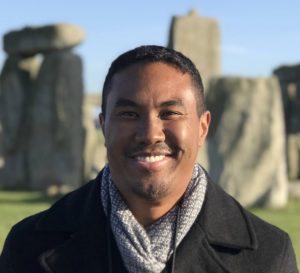 PhD
PhD
Richardʻs research interests encompass many areas but is primarily focused on dispersal patterns of reef fishes. He typically integrates phylogeographic and population genetic methods into his research to address questions regarding the mechanisms that are responsible for generating biodiversity in he marine realm, as well as informing conservation and management strategies for vulnerable fish populations. Richard is also a trained closed-circuit rebreather diver and has participated in several international expeditions of mesophotic environments.
Richard’s dissertation was titled “Connectivity of coral reef fishes across three spatial scales“.
Eric Tong


Postdoctoral Fellow
The Hawaiian spinner dolphin (Stenella longirostris) is found throughout all of the main Hawaiian Islands and some of the Northwest Hawaiian Islands and is genetically distinct from other spinner dolphin populations worldwide. The goal of this research is to determine the genetic structure within the Hawaiian spinner dolphin population. Hawaiian spinner dolphins are found closely associated with islands and are rarely seen in the deep channels between the islands. Within the Hawaiian spinner dolphin population there is plasticity of social structure—in the Northwest Hawaiian Islands they have more stable social groups whereas in the Main Hawaiian Islands they have more fluid social groups. Data on the genetic structure of these dolphins will be used to determine which ecological factors, such as geographic distance between islands or differences in social structure, are creating barriers to gene flow within the Hawaiian spinner dolphin. These data will allow assessment of the conservation status of the Hawaiian spinner dolphin as well as recommendations for the development of effective management units within the population. Preliminary results suggest that spinner dolphins at each of the Main Hawaiian Islands form a genetically distinct population, and these populations are distinct from the Northwest Hawaiian Islands.
 Postdoctoral Fellow
Postdoctoral Fellow
I am broadly interested in the biotic response to environmental change and the subsequent consequences of such change. My research interests are multifaceted and span across organization levels including individual processes (i.e., physiological parameters, protein and gene expression), community level interactions (i.e., community metabolism, recruitment, biomass, biodiversity, and community structure), and ecosystem function (i.e., terrestrial to marine connections). Through this integrative approach, I seek to reveal insights into ecosystem health and resilience and future patterns of biological diversity, while providing practical solutions to managers, policymakers, and communities.

PhD
In the near future, the threat of Global Climate Change will increase dramatically. Natural resource managers around the world will be faced with the challenge of how to combat a universal problem on local scale. Because of the minimal response of national and international communities to this imminent threat, the responsibility will likely fall on the shoulders of local area policy makers, ecologists, and resource managers to develop effective conservation strategies. My research focuses on developing an ecological framework from which to understand the response of corals to large-scale environmental changes. I am examining specific internal mechanisms that the corals and their associated symbionts can use to survive environmental stresses, specifically, the production of heat-stress and antioxidant defense proteins. If it is shown that intrinsically some corals are predisposed towards surviving stress, than it is important to protect these areas from local disturbances so they may serve the purpose of regeneration after large-scale mortality events.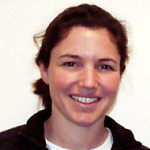
Postdoctoral Fellow
Iliana completed her post-doc in the ToBo lab in 2006 before moving to a faculty position at Penn State. Molecular evolution and ecology encompasses studies of process on three different time scales – affecting populations, affecting species, and affecting long-term molecular evolution. Her interest lie in testing ecological and evolutionary hypotheses concerning all three time scales. She focuses on research projects that can contribute to both the basic understanding of ecosystems and have applications in conservation biology. Currently, she develops and apply molecular tools to understand the influence of biogeography, population structure, and mating patterns on the survival and evolution of corals and other marine organisms.

Postdoctoral Fellow
My research interests lie at the intersection of population / phylogenetics and genomics, community ecology, and evolutionary biology and are focused on describing and understanding ecological and evolutionary processes in natural populations. I am deeply interested in elucidating the factors – especially ecological factors – affecting gene flow that lead to the generation of genetic diversity, population partitioning, reproductive incompatibility, and speciation. I have a particular bent towards pursuing lines of research with practical relevance to human concerns such as supporting the development of sustainable fisheries, detecting and controlling alien invasive species, and rehabilitating degraded marine systems via marine protected areas and other means. The majority of my research has been focused on limpets due to their cultural importance and crashed fishery status in Hawaii, but I am broadly interested in a variety of marine species from algae to invertebrates and fish. I also have an interest in developing statistical methods and making complex statistical techniques more accessible to biologists.
Brian Boeing

Masters
Brian completed his Master’s degree in Oceanography in 2007 before departing to travel around the world for a year. His research focused on coral bleaching. Coral bleaching, in which corals lose their photosynthetic algal symbionts, is a phenomenon that is recognized as one of fundamental ecological importance. However, mechanisms by which bleaching occurs are not at all well understood. Nitric Oxide Synthase (NOS) is an enzyme which beaks down the amino acid arginine to form the free radical gaseous signaling molecule Nitric Oxide (NO). It has previously been shown that the amount of NO produced by the algal symbiont corresponds to the amount of bleaching undergone by that particular coral colony. Also different types of algal symbionts that live inside the corals produce different amounts of NO under the same stressed conditions and therefore undergo different amounts of bleaching. Biochemical and molecular biological tools will be used to study the dynamics of the coral-algal symbioses, which will present a more clearly defined picture of the intricacies of coral bleaching.

Postdoctoral Fellow
I am a quantitative ecologist with experience in both field biology and “big data” projects. At the core of my research are questions of why organisms end up where they do and what that can mean for their future, and ours, given predicted changes in global climate and increasing human impacts to many of the world’s ecosystems. I have broad taxonomic interests and experiences (e.g. fishes, plants, invertebrates, mammals, birds, turtles) and employ a variety of analytical methods (e.g. niche modelling, landscape/seascape simulations, generalized linear models, machine learning) to address my research questions. However, my research interests and experience can generally be organized into one or more of the following three interconnected categories:
1) Understanding what drives distribution and movement of organisms across time and space
2) Predicting what our knowledge of those drivers could mean for the future of biodiversity
3) Improving management and conservation strategies to minimize negative effects on ecosystem function and resilience

PhD
From his graduate page: Tropical reef habitats are imperiled by global warming, over-fishing, pollution, invasive species, and various other challenges. Conventional SCUBA has revolutionized the exploration of these ecosystems over the recent past; however, due to SCUBA depth limits, estimates of reef-associated biodiversity suffer from incomplete sampling, leaving the deeper (50–150m) regions of the coral-reef environment almost entirely unexplored. Utilizing advanced diving technology in collaboration with researchers at the Bishop museum, I seek to analyze fish diversity in the unexplored lower two-thirds of tropical coral-reef ecosystems. For my dissertation I am studying distribution patterns of these mesophotic reefs within the Pacific (based on qualitative faunal assemblages, species distributions, and phylogeographic analyses) to illuminate the origins of deep-reef fish biodiversity.
Unfortunately Josh passed away on November 12th 2019, during a rebreather dive in the Solomon islands, months before he was due to defend and be a father for the second time. It was a huge shock to the lab and an exceptionally difficult loss to deal with especially by his wife, and fellow Tobo lab member Cassie Ka’apu-Lyons, and family. He was an amazing husband, father, researcher, explorer, and lab mate, and will not be forgotten. His dissertation has since been completed and he posthumously received his PhD.
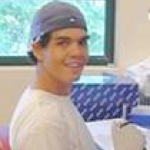 PhD
PhD
Greg is interested in the systematics and phylogeography of scleractinian corals, and is working on the phylogeography and evolution of Hawaiian Acroporid corals for his dissertation. He has been developing new molecular markers to use for his research as a graduate student starting this fall. He is currently evaluating these new tools for use in clarifying species-level relationships among scleractinian corals, and together with a variety of collaborators is trying to complete a world-wide phylogeny of the coral genus Pocillopora. Greg is also collaborating with Marc Crepeau and Sam Kahng on a study of the snowflake coral, Carijoa riisei. The snowflake coral was first reported in Hawaii in 1972 and has since spread throughout the main Hawaiian islands. Unlike the hard corals more familiar to us in Hawaii, Carijoa is a soft coral forming erect, branching colonies with thin, flexible stems. Based on morphological characters, this soft coral was identified as Carijoa riisei, which is native to the western Atlantic. Using DNA marker technology we are studying the phylogeography of Carijoa to determine how it has spread across the Pacific. When did Carijoa arrive in Hawaii and where did it come from? Did this species arrive once and spread, or has it been introduced repeatedly? How has this coral managed to spread so quickly throughout the Hawaiian Islands? How are the populations in Hawaii related to populations elsewhere in the Pacific? Are the populations throughout the Pacific also invaders? The answers to these questions will not lead to the eradication of Carijoa, but the answers may help us learn how the coral got here, how to prevent it from spreading further, and possibly where to look in order to prevent future introductions.

Postdoctoral Fellow
My research focuses on explaining the processes which create patterns of marine biodiversity. To accomplish this, I use both traditional, systematic approaches, as well as recent advances in coalescent theory and its application to phylogeography. In collaboration with several members of the ToBo Lab, as well as colleagues both abroad and in the U.S., I work towards understanding how processes like speciation and its relative rate and ease may affect parameters such as species richness and diversity over evolutionary time scales. Speciation in the marine environment remains a challenging topic in evolutionary biodiversity. The presence of a pelagic larval stage in many marine organisms makes it difficult to describe mechanisms of speciation as this life history trait may swamp out many historical signals that are more easily detected in terrestrial systems.

Lab manager
Marc worked as our lab manager from 2004-2006, before moving on to manage a medical lab in Mexico. He is currently a Staff Research Associate at University of California, Davis in the Department of Evolution & Ecology

PhD
After completing her PhD in the lab Annick received a prestigious postdoctoral fellowship at Woods Hole Oceanographic Institute working on the connectivity of barnacles in nearshore marine protected areas in South California.
PhD Thesis: “Resilient reefs: genetic connectivity of corals in Palau.”
Sarah Daley

EPSCoR facility manager
Sarah came to Hawaii from Davis, where she worked in the DBS core sequencing facility. She set up and ran the EPSCoR Evolutionary Genetics facility at HIMB from 2003 – 2006. In her spare time around that full-time job, she developed and optimizing microsatellite primers for isopods of the genus Idotea in a collaborative project with John Wares at the University of Georgia. She has moved on to Arizona where she is working in a medical lab and taking graduate classes in preparation for veterinary school.

PhD
Currently, Toby is working as an Assistant Professor at the University of West Florida. Her research interests include shark reproduction, genetics, phylogeography, and taxonomy.

Postdoctoral Fellow
Research Interests: My research is directed towards understanding the origins of species-level biodiversity and how it is maintained. I am therefore interested in the integration of classical and molecular approaches to resolve patterns of genetic variation within and between marine populations (or species), identify historical and contemporary factors that influence separation of such populations (or species), incorporate phylogeographic findings into the design of marine protected areas, and track evolutionary responses in natural (or experimental) populations. I use carefully selected model systems, along with DNA sequencing and computer simulation, to answer a diverse set of questions addressing the origins and persistence of biodiversity at multiple levels.
Past research systems have included lemon sharks in the Bahamas (funded by NSF), coral reef fish in the greater Indo-Pacific with a particular focus on the Hawaiian archipelago (funded by NSF and NOAA), and a globally distributed herring complex (funded by AMNH).
My current projects build on our phylogeographic study of Indo-Pacific reef fish to investigate the process of speciation in the Red Sea and Arabian Sea. This research is funded by the National Geographic Society in collaboration with researchers at King Abdullah University for Science and Technology (KAUST), California Academy of Sciences, and James Cook University. Other projects include an investigation of the quantitative genetics of adaptation in marine organisms facing climate change (in collaboration with researchers at Stony Brook University), using meta-analytic approaches to understand temporal and spatial variation in selection in the wild, and the role that MHC genes play in sexual selection in natural lemon shark populations.

PhD
Kanesa completed her dissertation on scalloped hammerhead sharks in 2005, and promptly moved on to a teaching position in Biology at Manoa. She is an Associate Professor at the Curriculum Research & Development Group (CRDG) in the UHM College of Education and Director of the Center for Marine Science Education. Her PhD research focused on the importance of nurseries for juvenile hammerhead sharks: We know that nurseries are important habitats for newborn scalloped hammerhead sharks (Sphyrna lewini) for at least a year. However, we wondered about the importance of specific nurseries, like Kaneohe Bay, to populations of scalloped hammerhead sharks. To investigate this, we collected small clips of shark fin from baby sharks in nurseries around the world. We collected from the Pacific, Indian, and Atlantic Oceans: 258 sharks in total. We then used these shark fin clips to compare the mitochondrial DNA from sharks in different nurseries. Since mtDNA is passed only from mother to offspring (fathers don’t contribute mtDNA), this allowed us to determine if female sharks, like salmon or sea turtles, return to their home nursery every breeding season. We have found a high degree of genetic separation between nurseries, but we also see evidence of straying. In other words, it looks like hammerheads generally return the area where they were born, but they are not as loyal to these areas as sea turtles are to their home beach or salmon to their home stream. Our data also suggest that the first scalloped hammerhead evolved in the Pacific Ocean, spread into the Indian Ocean, and then into the Atlantic. We also see that there are more sharks traveling between the Pacific and Indian than from the Indian into the Atlantic. This data is important because it confirms that scalloped hammerheads generally do return to their home nursery. This behavior means that populations are relatively local, and therefore more easily over fished. It also provides a mechanism for hammerhead sharks to isolate populations and develop into new species, which has happened seven times in the genus Sphyrna. And, we now think that there may even be a newer eight species in the Atlantic Ocean.
PhD
The Northwestern Hawaiian Islands are one of the few coral reef ecosystems that receive little direct human influence. Spanning about 1200 nautical miles, these islands support ecosystems teeming with life. The remote nature of the reefs both protects them, and endangers them. My research will use molecular techniques to address important questions about coral reef ecosystem monitoring and marine reserve design. For a couple of years, I have been working with the National Marine Fisheries Service in the Coral Reef Ecosystem Division to categorize benthic habitat with video towboard surveys of these remote coral reefs. The goal is to characterize the ecosystem regularly and identify change. Some questions to be addressed by molecular techniques are: how much overlap is there between populations of the various islands of the NWHI? For example, if an entire coral population on one island were lost to bleaching, would new recruits come from elsewhere? The identification of adult and newly settled coral recruits with genetic methods is a potentially useful tool, because visual identification is problematic.

PhD
The collection of fishes from the wild for the aquarium trade is a hot issue here in Hawaii due, in part, to documented declines in the abundance of collected species. The state of Hawaii stands third as a world source of aquarium fishes, exceeded only by exports of live specimens from the Philippines and Singapore. Recently, Hawaii has made attempts to mitigate impacts from the aquarium trade through the establishment of a series of experimental aquarium no-take zones along the Kona Coast. Whether our attempts to manage marine populations are ultimately successful is dependent on our understanding of how marine species interact with their environment. The life cycle of most reef fish consists of an early larval phase that is potentially subject to dispersal by ocean currents. Through genetic examinations of the popular Hawaiian reef fish, the Yellow Tang (Zebrasoma flavescens) we are working to better understand how to optimize the success of Marine Protected Areas by identifying patterns of larval dispersal among and within islands.

 PhD
PhD
Anuschka was a student of Mike Hadfield, but worked on two projects in collaboration with our lab. She first finished a phylogenetic study of host preference in Phestilla nudibranchs (Faucci et al. 2006), and is now working to revise and submit her dissertation project for publication. Her main dissertation research focused on the systematics and phylogeography of vermetid gastropods in the Hawaiian Archipelago, and the role of life history differences in patterns of connectivity among marine invertebrates. Anuschka has taken a position as the Laboratory Coordinator for the Marine Biology program at UH Manoa since she graduated.
 Postdoctoral Fellow
Postdoctoral Fellow
“I am interested in the patterns and processes that generate and maintain marine biodiversity and working towards solutions for the various environmental issues that are pressing marine ecosystems.”
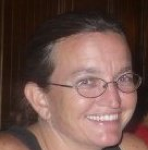
PhD
My research interests center on elucidating barriers to dispersal and understanding the sources of biodiversity in the sea. Some barriers to gene flow are apparent such as the large spans of open ocean that isolate the Hawaiian Islands. Of particular interest to me are those regions of phylogeographic distinction where no obvious physical barrier exists such as the Marquesas Islands which exhibit 12% endemism in shore fishes. In my research, I combine phylogeography and ecology to examine the spatial distribution of genetic diversity at the species level. By studying many taxa across large geographic and temporal scales patterns begin to emerge that ultimately add to our understanding of how species evolve.
I am currently part of a long-term project investigating speciation in coral reef fishes in the Indo-Pacific. As part of this endeavor I am incorporating high-throughput sequencing technologies to examine speciation in the genus Centropyge and among sister taxa of the genus Acanthurus.
 Masters
Masters
While coral reefs around the globe are threatened with environmental changes, soft corals are thriving on many West Indo Pacific coral reefs (picture). Regardless of the increasing prominence of soft corals in these ecosystems, the taxonomy of this group remains uncertain. Taxonomy is of importance in order to monitor and manage coral reefs, as well as to perform research regarding interactions, habitat preference, competition, abundance, etc.
Therefore, we study the evolutionary relatedness among soft corals from the Red Sea, using both molecular and morphological characters. We have amplified 5 nuclear loci (ITS, 28S, ATPsα, ATPsβ & SRP54), and 3 mitochondrial loci (msh1, CO1 & ND2), and are looking at a range of morphological characters such as: colony shape, sclerites shape, sclerites surface structure, and poly pinnules arrangement and number.
So far we have found that mtDNA and nDNA markers both provide similar resolution in phylogenetic analysis. Also, our results indicate that the molecular taxonomic groups do not always agree with the groups that were based on traditional morphological characters, and therefore we have to continue looking for further morphological characters that will help us distinguish between the phylogenetic clades. Additionally, we have performed a first systematic survey of Saudi Arabian alcyonacea.
This study is in collaboration with Cathy McFadden and Alex Reynolds from Harvey Mudd College, and Yehuda Benayahu and Anna Halasz from Tel Aviv University.

Postdoctoral Fellow
“Dr. Jean-Paul Hobbs is an Australian marine biologist currently employed as a Research Fellow in the Department of Environment and Agriculture at Curtin University in Perth, Western Australia. His research focuses on assessing human impacts on marine organisms with the ultimate goal of characterising and mitigating threats to marine biodiversity and fisheries resources.
Most of his research is conducted on coral reef ecosystems because these are the most biodiverse marine communities in the world and are also among the most threatened by human impacts. This research covers a range of scales from global studies on macroecology, phylogeography and biogeography through to long-term monitoring of population changes and studies of life history traits, behaviour and stress responses of individuals. To conduct this research requires a combination of fieldwork, aquarium experiments, and laboratory analyses. Although this research spans a range of organisms, the main study group is reef fishes of the Indo-Pacific and Red Sea.”
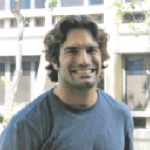
PhD
Matt’s interests include community ecology, conservation biology, & population genetics. He used molecular genetic techniques to study the population genetics of Hawaiian spiny lobster (Panulirus marginatus) and scaly slipper lobster (Scyllarides squammosus) across the Hawaiian archipelago. He also was involved in projects tracking movements of California spiny lobster (Panulirus interruptus) using both mark-release-recapture and genetic techniques.

Masters
“As a Tennessee native, some eight hours from the nearest coast, many ask what inspired Garrett to study marine biology, to which he replies “I just looked at the ground”! In his youth he noticed fossils from an ancient seabed all over his hometown. This raised many questions and eventually led him to pursue his Bachelors in Marine Biology at James Cook University in QLD, Australia. Post graduation he moved to the UK to work for a rebreather and dive computer manufacturer where he developed a passion for electronic design. Garrett is currently in pursuit of a masters degree through the University of Hawaii at Manoa and the Hawaii Institute of Marine Biology. There, he is combining his two passions, electronics and marine biology, to study fish populations on the deepest portions of Pacific Coral Reefs. With the advent of closed-circuit rebreather technology these reefs, known officially as Mesophotic Coral Reefs, are alas being explored. Garrett’s mission is to characterize fish populations that exist on Mesophotic Reefs as well as to determine if they may possibly serve as a refuge or ‘seed bank’ for fish species that also occur on shallower reefs. His role on the Expedition will be to assist in conducting fish surveys at all sites visited. Fish surveys serve as an excellent and straightforward method of determining the overall health of coral reef systems. Marine biologists are assigned the huge task of protecting the world’s coral reefs, and fish-surveys help us determine what lives there and their abundance so that policy-makers can make more-informed decisions in future marine policies.” From Living Oceans Foundation website

PhD
I am interested in the mechanisms that structure populations and shape species. Are the distribution and abundance of species and populations a result of chance; i.e. neutral theory suggesting demographic stochasticity? Or are populations structured by a combination of hydrodynamic features and species-specific ecological differences; i.e. differences in fecundity, reproductive mode, dispersal capabilities of larvae, larval behavior, niche, etc.? How are common species maintained across their range and what allows rare species to persist? To begin to delve deeper into these questions my dissertation focuses on corals in the genus Pocillopora.

PhD
Sam completed his dissertation in 2006, focusing on black coral. Hawaii’s black coral is used to make jewelry and other objects, and is the official state gem of Hawaii. The black coral industry in Hawaii is currently worth an estimated $30 million-per-year. However, this industry is now threatened by the growth of the snowflake coral, Carijoa riisei. The snowflake coral is overgrowing black coral colonies and invading large expanses of barren areas on the ocean floor. Despite its potential economic significance very little is known about the origin, reproduction and dispersal of Carijoa. Although typically known as a shallow water species, in its native range, in 2001 deep-water surveys near Maui discovered Carijoa riisei overgrowing many dead black coral colonies where healthy live black corals had previously dominated at depths of 65-115 meters. In shallow water, Carijoa is limited to areas with ledges and ridges that provide shade in shallow water, but the coral grows explosively into the open at depths of 180 or deeper. Sam is working on the ecological impact and potential for control of Carijoa riisei in Hawaii. The beautiful, but deadly, snowflake coral has exploded in abundance and is still spreading at depth throughout Hawaii. Sam is especially interested in studying the characteristics of this species that make it so effective at monopolizing these deep habitats as a model to understand invasions in the marine habitat.
 PhD
PhD
Herbivorous reef fishes, an extremely important component of coral reef communities, are generally categorized into several dietary functional groups. Recent work suggests, however, that there is far more complementarity within these groups than previously imagined. My dissertation research examined this specialization and resource partitioning in herbivorous reef fishes at multiple spatial scales ranging from a Pacific-wide analysis of herbivore assemblages down to individual specialization within species at a site. I use hierarchical models to examine trends on large spatial scales and molecular methods, namely metabarcoding, to identify unknown turf algae in the guts of surgeonfishes. Moving forward, I’m particularly interested in exploring how human impacts are affecting reef herbivores through numerous mechanisms such as habitat degradation and pollution. Email: enalley@nullhawaii.edu or eileen.nalley@nullgmail.com
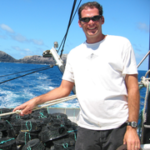
PhD
In 2000, after 25 years of operations, the Hawaii-based commercial fishery for spiny lobster (Panulirus marginatus) and slipper
lobster (Scyllarides squammosus) in the Northwestern Hawaiian Islands was closed because of increasing uncertainty about the status of the lobster stocks and the mathematical population models used to assess the stocks and their abundance. The NWHI lobster fishery had been one of Hawaii’s largest commercial fisheries and information on the lobster populations represented one of the longest time-series in the region, providing potentially key information on the status of the NWHI ecosystem. I have been working at the National Marine Fisheries Service, Fisheries Biology and Stock Assessment Division to provide the necessary key biological information missing from our understanding of lobster life history strategies. Current research, aboard federal research vessels and chartered fishing vessels, include a large-scale tagging program for information on lobster growth rates, movements, and natural mortality, a trap camera system that records lobster behavior in-and-around traps, and various attempts at understanding recruitment processes. I am also interested in how large environmental shifts effect lobster populations and biology.

PhD
I am broadly interested in the processes that regulate population connectivity and microevolutionary patterns in marine invertebrates. My dissertation research focused on two main topics:
1) The role of life history characteristics in governing population connectivity, phylogeography, and speciation in Asterinid sea stars
2) The effect of large human populations on the population connectivity of marine organisms
I use traditional and next-generation molecular techniques to estimate genomic patterns of selection and migration and analyze these patterns in a geographic context using landscape (or seascape) genetic models. For example, I recently published a paper (Puritz and Toonen 2011) documenting that coastal pollution is forming barriers to larval dispersal in a widely dispersing sea star species. Additionally, I was awarded an EASPI NSF Fellowship and spent this past summer in Australia collecting samples to investigate the impacts of coastal sewage disposal on the population connectivity of a local sea star.
My research program also focused on the use of next-generation sequencing for molecular ecology. During my dissertation work, I developed or helped to develop six nDNA sequence loci in seven different sea star species (all with little preexisting genomic information), and I successfully adapted five of these loci to use with 454 next-generation sequencing. Using a multiplexing technique (In Press at PLoS One), I successfully sequenced nearly 3200 nDNA loci (5 loci in 2 species across 16 localities with about 20 individuals per species per locality). In addition to the 454 platform, I am working on a speciation project using the RAD tag methodology on the Illumina sequencing platform.
Lab Technician
Pakki worked with us as a lab technician for a year before moving on to graduate studies at Humboldt State with Megan Donahue.
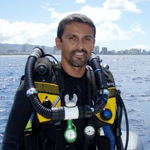
Assistant Researcher
Luiz left us for a faculty position at the University of Texas at Austin’s Marine Science Institute. He has since taken the position of Assistant Curator and Follett Chair of Ichthyology at the California Academy of Sciences. His research interests and experience are centered on the evolution, phylogeography (or the geographic distribution of genetic lineages), biogeography, systematics and community and behavioral ecology of coral reef fishes. He frequently combines these fields, invoking ecology to help explain evolutionary patterns and using molecular tools to test biogeographic and systematic hypotheses. The overall objective of this interdisciplinary research is to test existing hypotheses (and propose new ones) about what generates and maintains the extremely high biodiversity in tropical coral reefs.

Postdoctoral Fellow
I divide my time between three areas: marine population genetics, big-picture conservation science and improving access to local and sustainable seafood. My population genetic work has focused on understanding spatial patterns of gene flow and diversity in coastal marine settings, such as the Southern California Bight and synthesis work on genetic approaches to elucidating marine connectivity and larval dispersal. I am specifically interested in extending multivariate statistical model testing to determine the influence of seascape and ecological factors on genetic patterns, especially in a multi-species context. For instance we plan to extend the work of Toonen et al. (2011) Journal of Marine Biology to build a community-level picture of similarities and differences in connectivity patterns across the NWHI. My work on the topic of conservation science has focused on mapping human impacts to the oceans, including a study of human impacts in Papāhanaumokuākea. I will continue to work on ways to extend human impact assessment and mapping, and I am also beginning a new collaborative project to identify thresholds of state-change in marine social-ecological systems and develop useful indicators of pending transformation in these systems. My work on local and sustainable seafood has focused in Santa Barbara, where I am Associate Research Faculty at the Marine Science Institute at University of California Santa Barbara. I am currently collaborating with social scientists to understand the motivations and outcomes of seafood direct marketing arrangements, such as Community Supported Fishery (CSF) programs, and I am helping to start a CSF in Santa Barbara. Updated April 2012.

PhD
Jenny Schultz got her PhD in Zoology in 2009, and has stayed on Coconut Island as an Affiliate Faculty/ Assistant Researcher/SOEST Young Investigator at HIMB. Her projects, in her own words:
Have you ever wondered why some marine fish are found throughout the world and others are only found locally? It is not surprising that highly migratory oceanic species are widely dispersed; likewise, ocean currents may carry fish eggs and larvae very far. But how is it possible that a live-bearing species with limited movement can be found in all oceans? The lemon shark is one such species. Individuals give birth to live young and have a small home range, yet both Pacific and Atlantic species exhibit a wide distribution throughout their respective ocean basins. Is their present-day distribution reflective of an ancient dispersal before the spreading of continents or the emergence of oceanographic or geological barriers? Or do these “coastal” sharks migrate much farther than we realize, even across the open ocean? I will answer these questions by comparing the DNA of lemon sharks from throughout the world.
My second project revolves around the endangered Hawaiian monk seal which is found only in Hawaii. Until a few years ago, you would have to go to the Northwest Hawaiian Islands (NWHI) to catch a glimpse of one. Now, sightings are common on and off the shores of the Main Hawaiian Islands (MHI) as well. Though most NWHI seals were tagged as pups by the National Marine Fisheries Services, many of the MHI seals do not have tags. So where did these seals come from? Do these seals mate with NWHI seals? To answer these questions, we will compare the DNA from NWHI and MHI seals. In doing so, we will provide the National Marine Fisheries Services with important scientific data to aid in making informed management decisions.
 PhD
PhD
After completing his simultaneous Masters in philosophy and PhD in Biology at UH Manoa, he went on to complete his second PhD in philosophy at The Graduate Center, CUNY and is currently a lecturer in philosophy in the philosophy department at UPenn. For his PhD Derek worked on the population genetic structure of sea cucumbers (Holothuria atra & H. whitmaei) across the Hawaiian archipelago. In collaboration with members of Paul Barber& Gustav Paulay’s labs, he also worked on a study of population structure in these edible sea cucumbers across the entire Pacific.
Laurie Sorenson

Lab Assistant
Laurie worked in our lab as part of the NSF/Sea-Grant funded Marine Science Undergraduate Research Fellowship (MSURF) program before becoming a lab assistant on a variety of projects for the remainder of her undergraduate degree. She did a great job and moved on to a masters at VIMS and a PhD at UCLA.
Zoltan Szabo
 Postdoctoral Fellow
Postdoctoral Fellow
Zoli came to us as a former post-doc in the UH Manoa medical school who decided that he wanted to spend less time searching for mutations in elastin, and more time diving. He is working on a number of projects to retrain as a marine biologist as he makes ends meet by managing the lab and helping out with various research projects.

PhD
For her doctoral study, Lindsay used applied mathematics to answer ecological questions about the why, when, and where of the spatial ecology of various marine organisms, including Leptoseris corals and invasive Avrainvillea alga. Her interests include finding creative ways to manipulate big data, exploring new programming languages, and reading about updated global climate forecast models. Following her graduation, Lindsay is working with the PacIOOS team under Dr. Brian Powell to parameterize a fine-scale biogeochemical model (the ESM2M–COBALT (Carbon, Ocean Biogeochemistry and Lower Trophics) earth system model) for Kāneʻohe Bay, Oahu.

Masters
Whilst in the Tobo lab Ellen worked on butterfly reef fish evolution and phylogeography in the Indo-Pacific. She then went on to become a Sturgeon Biologist at the South Carolina Department of Natural Resources.
 Masters
Masters
Her research interests were diverse, so narrowing her focus for grad school turned out to be a lengthy and meandering task which involved working on seabird foraging projects in Oregon and Alaska, ecotoxicology research in Maryland, and teaching marine biology in British Columbia. She ultimately settled on marine ecology and conservation and decided that the most promising and exciting conservation work lay in marine protected areas. Effective design and management of marine refuges requires detailed knowledge of population structure and connectivity. For her graduate work, quantified the relationship between the duration of pelagic larval stages of marine species and resultant population genetic structure as it relates to the design and effectiveness of MPAs. She went on to do a PhD in geography at Rutgers (Dissertation title: The River-Border Complex: Governing Flows in South Asia) and is now an assistant professor of geography at Penn State University.
 PhD
PhD
After he earned his PhD, Nick accepted a position as a postdoctoral scientist at Mote Marine Laboratory in Sarasota, FL. His dissertation research: Whitetip reef sharks (Triaenodon obesus) don’t seem to move around much. Though most sharks have to keep swimming in order to breath, whitetips can breathe while lying in place. They take advantage of this skill by resting in caves for much of the daylight hours, and only come out at night to feed on the reef. Despite spending so much time resting, whitetips can be found throughout the tropical Pacific and Indian Oceans. How do they maintain such a broad distribution if they never go anywhere? We’re examining that question using three different methods. First, we’re attaching electronic tags to whitetips that allow us to track their movements from a boat, or by monitoring them with underwater listening stations. Second, we are collecting pictures of whitetips to use for photo-identification. These sharks have spot patterns on their sides that are unique for each individual, and thus act as a fingerprint or a “natural tag.” We’re developing a photo library of individual sharks to keep track of when and where they have been seen. The third method we’re using is population genetics. We’re analyzing differences in the DNA of whitetip populations throughout the tropical Indo-Pacific. Taken altogether, this research should tell us if whitetip reef sharks really are as site-attached as they seem, and how much gene flow takes place between apparently isolated populations. This information is critical for management purposes because shark populations around the world are in decline from over-fishing.
 PhD
PhD
My overall goal is to apply the methods that scientists have developed for pharmacological and medicinal research to ecological and evolutionary questions. Modern molecular methods, from microarrays to next generation sequencing, have the potential to revolutionize the way we study threatened ecosystems, habitats and species. Key questions include those investigating the origin and extinction of species, the evolution of novel traits or behaviors, how sequence patterns reflect evolution and selection, and the effect of anthropogenic activity on organisms at the genetic level.

PhD
I’m interested in ecosystem changes in the North Pacific, and the effect climate and fishing has on the central North Pacific. I got my Ph.D. in Oceanography in 2016 from UH Manoa and my dissertation research focused on larval dispersal and population connectivity in the Hawaiian Archipelago using a biophysical modeling approach. I am currently working as a Research Analyst for the Ecosystems and Oceanography Program at the Pacific Islands Fisheries Science Center (PIFSC) in Honolulu.